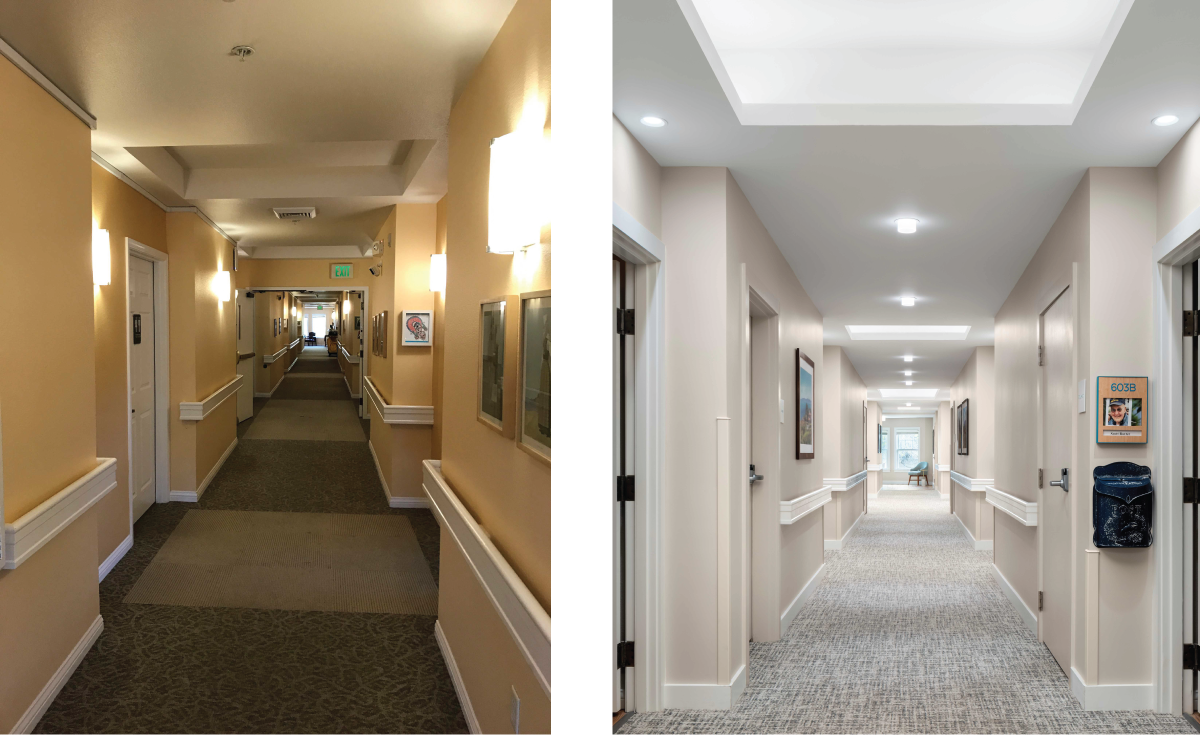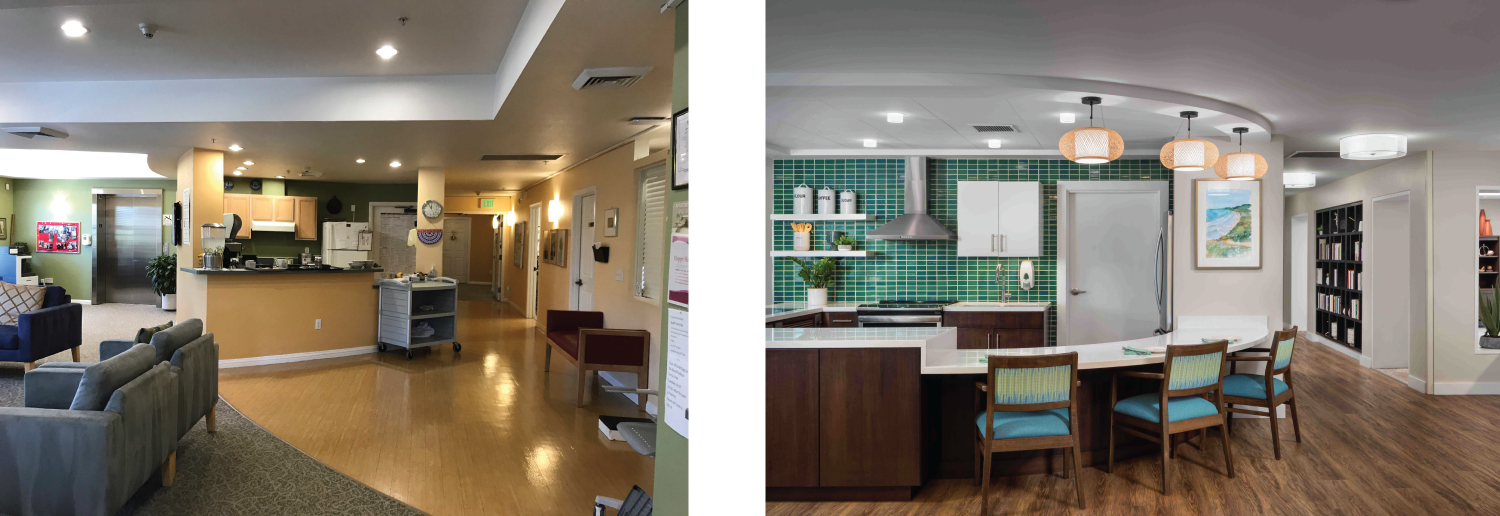
Designing for Dementia: What to Think about When Creating Spaces for People With Memory Loss
07/12/2023 | Blog | Reading Time 9 Minutes
Designing spaces for people experiencing dementia comes with specific and unique challenges. But before we start re-organizing, we need to think about how people with memory loss experience the world. Understanding this is the foundation for every design choice we make.
First and foremost, dementia impairs our memory. The severity of memory loss depends on the severity of the dementia, but it can include things like forgetting people’s names, significant dates, or what they were doing recently. This is important to keep in mind as we design spaces because it means people can forget where they are entirely.
Memory loss and dementia also impair our ability to learn. This symptom can make it difficult to adjust to changes in environments that were once familiar. Even small changes like new items on shelves or different pictures on the wall can cause people with memory loss to become disoriented. Completely new places can be especially challenging.
It’s difficult living with dementia or memory loss. Forgetting routine things and becoming easily disoriented results in high levels of stress. It’s not uncommon for environments and situations that were once comfortable, to now cause anxiety. It’s important to take this into consideration as we develop design goals to help people with dementia or memory loss live and thrive.
Dementia Design Goals
Because people with dementia experience the world differently, the spaces they live in must be designed differently. There are a few universal goals, however, that memory loss and dementia design strive to accomplish.
Designing for dementia is about creating safe spaces where the resident can have the freedom to make choices and live the life they want”
Soo Im, Principal at Perkins Eastman
Reduce Scale
People with memory loss or dementia can feel anxious or disoriented around large groups of people, expansive spaces, and loud environments. When designing spaces for them, we try to reduce the perceived size of the space and the perceived number of occupants. By reducing these perceptions, occupants can better cope with their surroundings. One method to accomplish this is called the Green House approach. In this approach, each senior has their own private room and bathroom. These private rooms can also include a living room, kitchen, and open dining areas.


In these before and after examples from our Rosenborg Memory Care center we tried to make the layout engaging. Instead of large open spaces, we used design elements to make the space feel like a home. We also included decorations that made the space feel less institutional and more residential. All of this was done so our residents feel comfortable and don’t feel overwhelmed.
Maximize Familiarity
Since living with memory loss is often confusing and disorienting, it’s important to try and maximize the familiarity of the space as much as possible. Objects that evoke memory or emotions like old photographs or favorite paintings can be placed in the living area to make the space feel more recognizable. Recently, reminiscence therapy has been used to try and accomplish this. Since people experiencing dementia are more likely to remember the past, reminiscence therapy tries to decorate living spaces with items and decor from their past. Examples would be things like rotary phones, older television models, or older styles of furniture. In the previous examples from Rosenborg, we used personal items and photographs to help residents locate their room.
Often times you don’t realize you’ve created a space where everything looks hospital-like or institutional. With Rosenborg, we wanted every space to be more residential and recognizable so our residents can more easily navigate the space.”
Gilbert Carrasco, former Executive Director, Life Care Services
Regulate Sensory Stimulation
People with memory loss or dementia are susceptible to sensory overload. When designing spaces for them, how every aspect of the design affects the senses needs to be considered.
Lighting
Proper lighting is crucial in creating a safe, comfortable environment. While bright lighting can improve visibility and reduce the risk of accidents, dim lighting can create a relaxing atmosphere. Natural lighting is also important. It has mental and physical benefits that artificial lighting simply can’t recreate. Natural lighting makes the space feel more comfortable and homey. Some ways to increase natural lighting include placing furniture near windows or using sheer curtains. Skylights are another good way to bring natural light into areas of the home that are darker.
Lighting can also be used to help with certain tasks, like reading, writing, cooking, sewing, or other intricate work. Task lighting can help improve visibility in specific areas or help add light to problem areas. Some examples of task light would be a reading lamp or under-cabinet lighting in the kitchen.
Something that is often overlooked is glare and lighting hotspots. Both can be distracting for people with dementia or memory loss. Installing lighting fixtures away from windows and using lampshades to diffuse the light can drastically reduce glare and hotspots. In the previous hallway examples, the uplit ceilings make it feel like daylight is coming in. We also removed all the lighting sconces to remove hotspots that might irritate residents.
We also implemented a groundbreaking circadian light system for our residents. We all have what is called a circadian rhythm. These are the signals our bodies use to tell us when to sleep and when to be active. During the day, our bodies receive sunlight and produce cortisol making us active. At night, the light we receive is reduced and our bodies produce melatonin, making us tired. Long-term care and assisted living residents oftentimes will have their circadian rhythms interrupted. Thanks to advances in lighting technology, we were able to design a lighting system that mimics the light a person would normally receive throughout the day. This helps improve our residents' mood and also helps them fall and stay asleep.
Color
Color is an effective tool used to accomplish several different things in designing for people with dementia. For example, contrasting colors can help everyday objects stand out, making them identifiable. Something like putting a dark colored chair against a light-colored wall can help someone with memory loss easily locate the chair and find their way to it.
Colors that stand out can also be useful for identifying important items or locations. A good example would be keeping medication bottles or emergency contact information in colored containers.
Patterns can be a good thing or a bad thing. It really comes down to the pattern and how it is used. Used incorrectly, it can make the space confusing and create difficulty wayfinding. In the previous hallway examples, the previous carpet design could be construed as a hole in the floor. This is an instance where color, contrast, and pattern combine to create an undesired effect. It was remedied by replacing the carpet with this new pattern that is relatively uniform and doesn’t create the illusion of holes or uneven surfaces.
Noise
Seniors in general can have a difficult time with loud noise. For people with memory loss, it can be especially aggravating. The recommended noise level for shared spaces is 40 decibels (dB). Despite this, most long-term care environments are much louder, approximately 57 dB on average. While this might not be enough to cause hearing damage, it is loud enough to cause emotional and physiological reactions, disturbed sleep, and delirium. This noise level is also linked to an increase of “fight or flight” reactions.
Some methods for reducing noise include insulated drywall, acoustic ceiling tiles, carpeted floors, wireless pagers, lubricated hinges, private bedrooms, and clinical offices instead of stations. For Rosenborg, we took special care to soundproof rooms with special ceiling tiles. This drastically reduced the noise level and created a more relaxing environment for our residents.
Safety Considerations for Dementia Design
In addition to lighting, color, and noise reduction, it is important to consider safety features in spaces for people with memory loss. Grab bars can be installed in bathrooms and other areas where individuals may need extra support. They can help reduce the risk of falls and provide extra stability.
Non-slip surfaces in areas like bathrooms, kitchens, and entryways greatly reduce the risk of falls. This can include non-slip mats or rugs and non-slip flooring surfaces. Safety locks are a good way to limit access to drawers and cabinets that contain dangerous items like sharp objects or cleaning supplies.
Integrating Technology into Memory Care Design
Technology can help create a safe and supportive environment for individuals with memory loss. Smart technologies can help automate parts of a space, including lighting and temperature control. Not only can this help individuals with memory loss navigate the home, but it can allow their loved ones to monitor the environment.
Motion sensors are a great way to implement technology to make spaces more accessible to people with memory loss. They can be installed in areas like hallways or bathrooms to automatically turn on lights when someone enters the room. Knowing that lights will always come on can give loved ones enormous peace of mind and significantly increases the safety of any space.
GPS tracking devices can be helpful for individuals who are at risk of wandering. These devices can help locate individuals who get lost or disoriented. They can also help people with memory loss locate items or locations in the home. Technology can also be used to help keep the mind stimulated. In our memory care building, we implemented the cutting edge iN2L computer system. iN2L is a content-driven platform designed to create meaningful experiences for older adults. It brings people together, connecting seniors with what interests and fulfills them. With iN2L, our residents can share with each other, their caregivers, and family members.
When Does Design Become Important?
Memory loss and Alzheimer’s isn’t a one-size-fits all disease. People with memory loss have different needs as their symptoms progress. In the early stages, the symptoms of dementia may not be noticeable. People in this stage may still drive, work in a job setting, and live a normal life. It’s still a good idea to make sure things in the space are labeled properly. And it’s never a bad idea to make sure their space is safe and free from slip, trip, and fall hazards.
In the midstage of Alzheimer’s, symptoms become more apparent. This is also the longest stage of dementia. People in this stage will start to forget things about personal history, have an increased tendency to wander, and experience confusion about what day it is or where they are.
At this stage, it might be time to consider moving the person to a memory care unit. At the very least, their home should be easy to navigate and free from safety hazards. It might also be a good time to look into something like reminiscing therapy.
In the final stages of dementia, people could experience loss of awareness of their surroundings and significant changes in their physical abilities. At this stage, the person will need around-the-clock assistance. Designing a space for individuals with memory loss requires careful consideration. At Aldersly, we understand the needs of people experiencing memory loss and the needs of their loved ones. As one of the most technologically advanced memory care residences in North America, Aldersly’s Rosenborg Memory Care is designed to enhance the life experience and overall wellness of people with Alzheimer’s or other dementias. We know what you’re going through and we’re here to help. Watch our video to learn more about the Rosenborg Memory Care residence or call us at (415) 432-7047 to schedule a visit.
Photos taken by Perkins Eastman.

